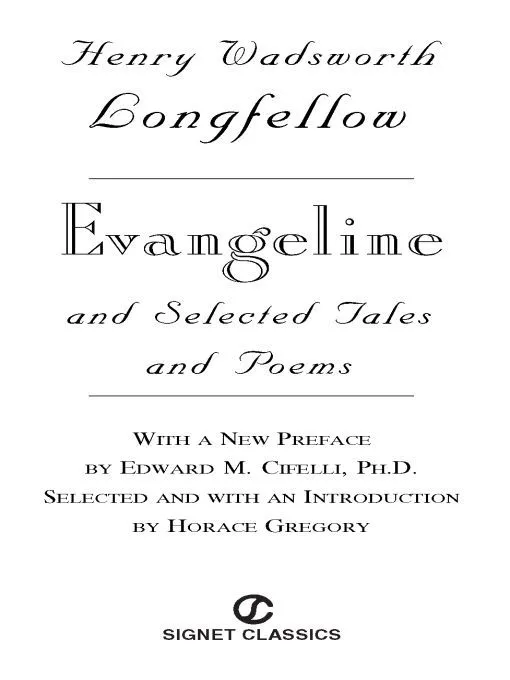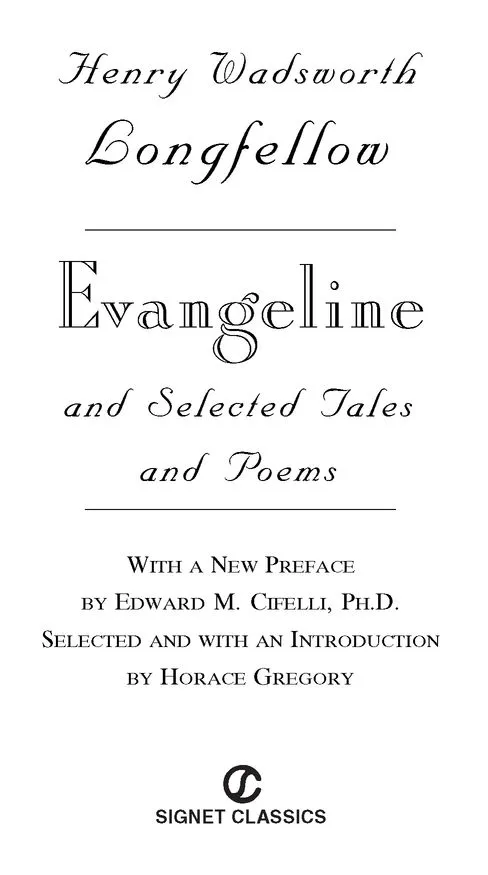Evangeline and Selected Tales and Poems

Table of Contents
Title Page
Copyright Page
PREFACE
Introduction
MEZZO CAMMIN
AFTERMATH
A PSALM OF LIFE - WHAT THE HEART OF THE YOUNG MAN SAID TO THE PSALMIST
HYMN TO THE NIGHT
BURIAL OF THE MINNISINK
THE SKELETON IN ARMOR
THE WRECK OF THE HESPERUS
THE VILLAGE BLACKSMITH
THE WITNESSES
THE BELFRY OF BRUGES
THE DAY IS DONE
THE OLD CLOCK ON THE STAIRS
EVANGELINE
THE BUILDING OF THE SHIP
TEGNÉR’S DRAPA
From THE SONG OF HIAWATHA
THE CELESTIAL PILOT
THE BELLS OF LYNN
SANDALPHON
VITTORIA COLONNA
HELEN OF TYRE
THE WARDEN OF THE CINQUE PORTS
HAUNTED HOUSES
IN THE CHURCHYARD AT CAMBRIDGE
MY LOST YOUTH
THE CHILDREN’S HOUR
PAUL REVERE’S RIDE
From THE SAGA OF KING OLAF
THE BIRDS OF KILLINGWORTH
THE SPANISH JEW’S TALE
CHARLEMAGNE
HAWTHORNE
THE CROSS OF SNOW
AMALFI
A DUTCH PICTURE
THE WHITE CZAR
JUGURTHA
THE BELLS OF SAN BLAS
TO-MORROW - (Mañana)
SANTA TERESA’S BOOK-MARK - (Letrilla que llevaba por Registro en su Breviario)
THE RETURN OF SPRING - (Renouveau)
THE COURTSHIP OF MILES STANDISH
APPENDIX - MARTIN FRANC AND THE MONK OF SAINT ANTHONY
COMMENTARIES
NORMAN HOLMES PEARSON
LEWIS CARROLL
The life of Henry Wadsworth Longfellow (1807-82) was a mixture of triumph and tragedy, fulfillment and disappointment. His youthful ambitions were all literary, but to please his father, he became a teacher. During the eight years he taught modern languages at Bowdoin College and the eighteen years he lectured at Harvard, he published thirteen books, including Evangeline (1847), the polemic Poems on Slavery (1842), and The Golden Legend (1851). Longfellow’s work was acclaimed throughout America and Europe. Two years after his death, a bust of Longfellow was unveiled in Poets’ Corner in Westminster Abbey.
Edward M. Cifelli, Ph.D., has taught British and American literature for more than thirty-five years and is the author or editor of seven books, including biographies of poets David Humphreys and John Ciardi. A regular essayist on poetry for several magazines, he is currently at work on a book about Arkansas poet Miller Williams.
Horace Gregory (1898-1982) was an American poet most noted for his dramatic structure and penetrating insights into the harshness of contemporary life. Among his volumes are Chelsea Rooming House (1930), Poems, 1930-40 (1941), and Another Look (1976). He also made translations of the poems of Catullus and of Ovid’s Metamorphoses.

SIGNET CLASSICS
Published by New American Library, a division of
Penguin Group (USA) Inc., 375 Hudson Street,
New York, New York 10014, USA
Penguin Group (Canada), 10 Alcorn Avenue, Toronto,
Ontario M4V 3B2, Canada (a division of Pearson Penguin Canada Inc.)
Penguin Books Ltd., 80 Strand, London WC2R 0RL, England
Penguin Ireland, 25 St. Stephen’s Green, Dublin 2,
Ireland (a division of Penguin Books Ltd.)
Penguin Group (Australia), 250 Camberwell Road, Camberwell, Victoria
3124, Australia (a division of Pearson Australia Group Pty. Ltd.)
Penguin Books India Pvt. Ltd., 11 Community Centre, Panchsheel Park,
New Delhi - 110 017, India
Penguin Group (NZ), cnr Airborne and Rosedale Roads, Albany,
Auckland 1310, New Zealand (a division of Pearson New Zealand Ltd.)
Penguin Books (South Africa) (Pty.) Ltd., 24 Sturdee Avenue,
Rosebank, Johannesburg 2196, South Africa
Penguin Books Ltd., Registered Offices:
80 Strand, London WC2R 0RL, England
Published by Signet Classics, an imprint of New American Library,
a division of Penguin Group (USA) Inc. Previously published with a
slightly different selection of writings.
First Signet Classics Printing, September 1964
First Signet Classics Printing (Cifelli Preface), January 2005
Copyright © Penguin Group (USA) Inc., 1964 Preface copyright © Edward M. Cifelli, 2005
eISBN : 978-1-101-15764-0
All rights reserved
SIGNET CLASSICS and logo are trademarks of Penguin Group (USA) Inc.
Library of Congress Catalog Card Number: 2004058910
Without limiting the rights under copyright reserved above, no part of this publication may be reproduced, stored in or introduced into a retrieval system, or transmitted, in any form, or by any means (electronic, mechanical, photocopying, recording, or otherwise), without the prior written permission of both the copyright owner and the above publisher of this book.
The scanning, uploading, and distribution of this book via the Internet or via any other means without the permission of the publisher is illegal and punishable by law. Please purchase only authorized electronic editions, and do not participate in or encourage electronic piracy of copyrighted materials. Your support of the author’s rights is appreciated.
http://us.penguingroup.com
THIS EDITION OF LONGFELLOW IS
INSCRIBED TO THE MEMORY OF MY MOTHER,
ANNA CATHERINE GREGORY,
WHOSE READINGS OF HIS VOICES OF THE NIGHT
ARE AMONG THE CHARMS OF MY EARLIEST MEMORIES.
PREFACE
Longfellow in the Twenty-First Century
THE RAINY DAY
The day is cold, and dark, and dreary;
It rains, and the wind is never weary;
The vine still clings to the mouldering wall,
But at every gust the dead leaves fall,
And the day is dark and dreary.
My life is cold, and dark, and dreary;
It rains, and the wind is never weary;
My thoughts still cling to the mouldering Past,
But the hopes of youth fall thick in the blast,
And the days are dark and dreary.
Be still, sad heart! And cease repining;
Behind the clouds is the sun still shining;
Thy fate is the common fate of all,
Into each life some rain must fall,
Some days must be dark and dreary.
—Henry Wadsworth Longfellow
Ballads and Other Poems (1842)
Yes, it was Longfellow who first said, “Into each life some rain must fall.” He had learned firsthand about pain and tragic loss when his wife suffered a miscarriage in 1835, and died of an infection shortly afterward. He wrote “The Rainy Day” some five years later, but its message, “Be still, sad heart!” would be put to an even harder test in 1861, when his second wife caught fire in a household accident and died suddenly. An ecumenical Unitarian, Longfellow did not put his grief in terms of standard Christian consolation, but instead took a humanistic tone to help himself, and everyone else in pain, to work through the “dark and dreary” days of their “common fate.” It is a tightly structured poem filled with an inner strength of purpose—just the type that would become unmistakably Longfellow’s as the years passed. Moreover, this sort of poem, the kind with a gentle, consoling tone and a warm uplifting theme, all wrapped in a tightly rhymed and metered verse, was enormously popular in the nineteenth century and goes a long way toward explaining Longfellow’s unequalled contemporary popularity.
But it also accounts for his twentieth-century eclipse. Modern readers have been drawn more and more to the tales and poems of Longfellow’s contemporary Edgar Allan Poe, partly because they can relate, far better than people of Poe and Longfellow’s time could, to Poe’s themes of mental illness and drug and alcohol abuse, as well as his persistent interest in the darker side of human nature. At the same time, modern readers gradually came to recoil from Longfellow’s wholesomeness, piety, and nationalism, which, it should be remembered, were a perfect match for the muscularly expansive mood of Manifest Destiny, America’s up-beat, nationalistic, boundary-expanding slogan of the 1840s. Poe’s personality quirks and his bad-boy psychological profile have made him irresistible to modern-day Freudians, while Longfellow’s reputation as the Goody Two-shoes of nineteenth-century American poetry, the man who brought poetry to the masses and became rich and famous doing it, has wearied and bored contemporary sophisticates, who clearly prefer their artists edgy, underappreciated, and stereotypi cally poor.
With the two hundredth anniversary of Longfellow’s birth approaching in 2007, however, the time is right once again to reread his poems and challenge the now-tired attitudes that have kept Longfellow from finding a new audience. And it is also a perfect time for this revised edition of Longfellow’s poems, so ably selected, edited, and introduced forty years ago by the mid-twentieth-century poet Horace Gregory and backed up by the likes of Norman Holmes Pearson, Van Wyck Brooks, and Lewis Carroll.1 Perhaps the time is even better now than it was then for a Longfellow resurgence, partly because the narrative poem has reemerged as a poetic form to be reckoned with—and partly because twenty-first-century readers are not as automatically dis missive of Longfellow as their immediate predecessors were. There is a new curiosity about the Longfellow phenomenon. What was there about this man and his work that made his seventieth birthday in 1877 something akin to a national holiday? Is it possible to account for Longfellow’s impressive sales, as for example the fact that on its first day in London bookstores The Courtship of Miles Standish sold ten thousand copies? And twenty-five thousand copies in the first two months in the United States?2 They want to know how it is that Longfellow is the only American poet to have had his bust put up in the Poets’ Corner in London’s famed Westminster Abbey. And new readers also want to know how it is that Longfellow, not Walt Whitman, seemed to the nineteenth century the poetic embodiment of democratic America. The twentieth century would reverse the judgment, but newcomers to Longfellow today are ready to discover for themselves how completely Longfellow spoke to his own time and place and countrymen.
Which does not mean Longfellow will ever again play as well as he did back then. Modern readers are not likely, for example, to warm very much to his quaint long-windedness, picturesque nostalgia, or fondness for moralizing. Nor will they ever enjoy plodding through some of the ponderous sections of Hiawatha and the other long poems. They will, however, recognize and admire Longfellow’s expert handling of short lyrics as well as his management of longer dramatic sequences, both of which he continues rightly to be well known for.
1 comment